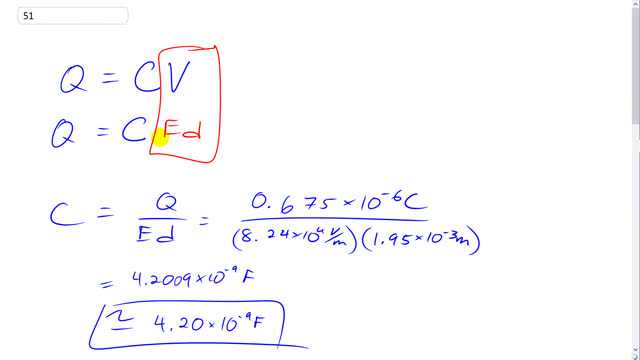
The electric field between the plates of a paper-separated (K = 3.75) capacitor is . The plates are 1.95 mm apart, and the charge on each is . Determine the capacitance of this capacitor and the area of each plate.

In order to watch this solution you need to have a subscription.
This is Giancoli Answers with Mr. Dychko. The charge on each plate is going to be its capacitance times the voltage across the capacitor and voltage is when you have constant electric field is going to be an electric field times the separation between these parallel plates. So we can solve this for C by dividing both sides by E d. So C is the charge divided by electric field times the distance between the plates. So that's 0.675 times ten to the minus six coulombs divided by 8.24 times ten to the four volt per meter, electric field, times 1.95 times ten to the minus three meters separation which gives 4.2 times ten to the minus nine Farads, must be the capacitance and we can solve for area knowing this formula for the capacitance for a parallel plate capacitor dielectric constant times Epsilon naught times area over separation between plates and we can solve for A by multiplying both sides by d over k Epsilon naught so the area of each plate is the capacitance times d over k Epsilon naught but capacitance is Q over E d. I mean I guess I could just substitute in this answer that we have here and not bother with substituting it with algebra but it's usually good to avoid using a number that you've calculated and use the numbers given in the question instead to avoid any errors that might result from using this number, this number might be wrong so we'll substitute Q over E d in place of C. The d cancel and we get the area then is Q over E k Epsilon naught. So that's the charge of 0.675 times ten to the minus six coulombs divided by electric field of 8.24 times ten to the four volts per meter times permittivity of free space 8.85 times ten to the minus 12 coulomb squared per newton meter squared times the dielectric constant for paper of 3.75 and you get 0.247 square meters must be the area the plates.
Thanks, this is very helpful!